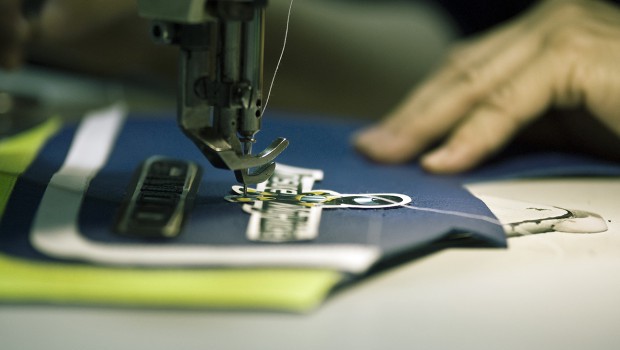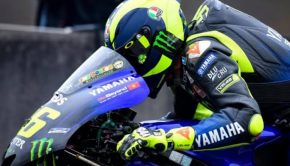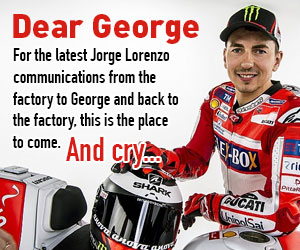MOTORCYCLE LEATHERS – ALL YOU NEED TO KNOW
By Ed Brown and Irena Saric
Leather, leather, leather… every second conversation in our lives seems to be about leather. We’re surrounded, squeezed and consumed by the stuff. The smell, the feel – it’s quite simply one of the greatest resources on this earth. And as motorcyclists, leather is a cornerstone of our lifestyle, and it also happens to be our business – Oz Motorcycle Leathers. We repair leathers for a living, and source high quality custom race suits from Italy.

The good old days…
We work with and on motorcycle leathers every day, speak to customers about their spills, and talk with the industry worldwide. We understand the science, and it’s fair to say we have a pretty good comprehension of how it all works – specifically when it comes to race suits. But the principles and issues apply to all leather motorcycle gear.
But you all know what leather is, right? That’s right, it is the skin of a dead animal that has been put through various processes to stabilise it, condition it and prepare it for use – and it is something mankind has been doing for tens of thousands of years.
However, motorcycle leathers are a relatively new thing on the human timeline. These are garments worn by motorcycle riders that offer the highest level of protection and comfort, both of which are very desirable properties when riding a bike. And leather is favoured by riders due to its robust abrasion protection and its flexibility.
One-piece racing suits originated in the 50s and the very early examples were made of horse leather. This quickly gave way to cow leather which offered similar resistance to abrasion but better flexibility.
Different types of cowhide are still the most common source of leather for motorcycle gear. But many racers now favour kangaroo leather due to its lighter weight and better resistance to abrasion.

“I can’t wait to see you set the lap record at the Isle of Man, boy!”
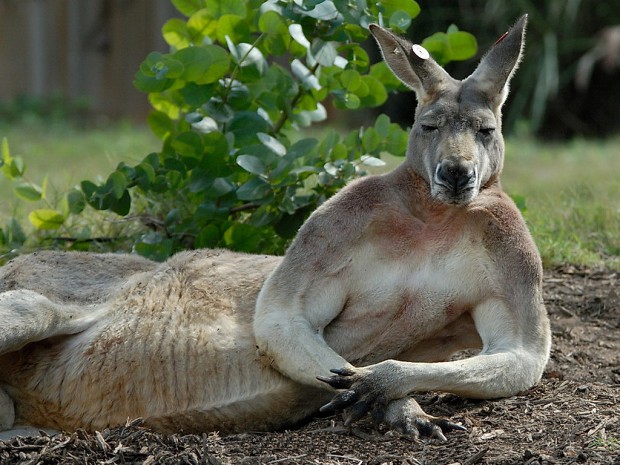
“I’ll show you ‘tough’, bitches.”
It goes without saying that good leather is better than poor leather, which raises the question of how do you tell the good stuff from the not-so-good stuff? Do most people really know what they’re buying? Does the salesman really know what he’s trying to sell you?
On principle, the price you pay is generally a good indicator of the quality of the leather you’re going to be getting. The selection of the animal, the condition of its hide and the standards of the processing stages all play a vital part in leather quality and affect the overall strength of the finished product.
It’s reasonable to expect a brand with an established reputation to use better quality leather than what you’ll find on a cheap eBay suit from Pakistan. The important thing here to remember is that the “You get what you pay for” truism also applies to the armour and general construction of the garment.
Most of the leathers on the market use a full-grain cowhide (that’s where you can see the marbled texture) of around 1.3mm in thickness.
You’ll usually get a variation of plus or minus a few tenths of a millimetre depending on the part of the hide used. Leather suitable for motorcycle clothing has a good resistance to abrasion and reasonable strength against tearing. And, interestingly enough, thickness is not as important as the hide’s overall quality – and good, strong leather should be soft and fairly supple.
HOW ABOUT THE FIT?
This is really important. Well-fitting leathers are fundamental to the performance of those leathers. This is why you do not see top-end racers with saggy race-suits on. And many race suits have a shortened front length, which reduces bunching of the leather when the rider is in a crouch over the tank.

Fits like a glove…that does 300km/h…

Big-name leathers like Spyke are copied and sold to people like this all the time.

Greeting Intl – a brand we can all ignore quite happily.
Leather will relax and form around your body to a certain extent, over time. So as long as the initial fit is OK, the armour doesn’t dig into your soft bits, and you can move around on the bike, some initial tightness is fine. Crotch to knee, shoulder to elbow, and shoulder to shoulder are important and where you should be looking for a good fit. A looser fit can be more comfortable, and allow you to stalk around the pits in relative comfort, but that loose stuff may bunch or grab in the event of a slide.
For most riders, unless they happen to fit a manufacturer’s standard size perfectly, an off-the-rack suit will be something of a compromise.
You should endeavour to find a balance between relative comfort while still ensuring that your leathers will hold the armour securely with a minimum of bunching. And remember that leather will not save you from impact injuries. That is the armour’s job. So it is crucial it doesn’t swim around inside your suit or jacket.
Now if you decide that compromise is not for you, and made-to-measure is the only way you’re going to play, expect to pay accordingly. If you are going to buy a suit with the intention of getting it altered, consider how much labour is involved in that exercise. It’s easier to shorten a sleeve than to lengthen it, but still not a big job compared to having to add or remove leather across the shoulders or hips.
ARMOUR
Most modern riding gear contains CE-approved protectors at the shoulders, elbows and knees. And while most people will tell you that “CE” stands for Conformité Européenne, meaning “European Conformity”, it actually stands for “Communauté Européenne”, which is French for “European Community” and simply means that a product bearing those initials is freely marketable in the European Economic Area.

When this goes wrong, armour is your best friend.
Happily, when it comes to motorcycle armour, it also means that the protector has been subjected to a test of how much force can be absorbed by the armour itself, and that the factory has met the requirements of the certifying authority.
The armour will also be stamped or badged with the CE mark and the standard EN 1621-1:1997, and all genuine sets of CE protectors are supplied with a booklet describing the testing standard and listing the details of the manufacturer. The protectors in most decent leathers are similar to those used by MotoGP and WSBK riders.
As well as the armour, modern race suits should have leather stretch-panels behind the shoulders, on the lower back and above the knees.

“Who’s your Daddy now, Turn Three?”
These allow for an increased range of movement on the bike. Elastic Kevlar panels on unexposed-in-a-crash areas inside the arms and legs also help with freedom of movement and will give a much better level of comfort when compared to suits without such panels.
Please understand that the inclusion of the CE-approved armour and Kevlar stretch-panels does not necessarily mean a suit is well made, but they should be features of any modern racing suit.
CONSTRUCTION
This is a crucial and often deciding factor in what separates a great suit from a mediocre one. So it pays to understand all about “hidden stitching” and what it looks like. Seams should always have a hidden row of stitching. Have a feel for it where the seam folds back. Top stitching only on a seam, however many rows of it are used, is simply unacceptable, and more common than you might think.

The visible stitching should be regular and evenly spaced along the seams. The stitch-line shouldn’t wander in and out from the edge. It doesn’t necessarily weaken the seam, but it is a good indicator of a rushed job. And all the threads in a leather race suit should be a bonded nylon, not cotton.
RACE HUMPS
Humps of various sizes can now be seen on a lot of one- and two-piece suits and are a relatively recent development for racing. They were initially conceived to reduce buffeting against the riders head at high speeds and thus reduce overall fatigue. Since their initial development, a fair amount of evidence has come forward demonstrating that humps also provide safety benefits in certain crash situations. So while they won’t make you any faster (Mick Doohan and Dave Jefferies never used them), it looks like humps are here to stay.

James East gets his hump on
THE INDUSTRY
Most of the big-name leathers sold in the shops and worn by riders are typically produced in countries with cheaper labour costs, like China, Ukraine and Tunisia. They are mass-produced to a strict budget, but a degree of quality control ensures the suits are of a fairly acceptable quality in most situations, and can maintain the credibility of the company.
Many of these manufacturers are licensed to produce their own branded CE protectors, thus allowing them to ensure the armour used is of an acceptable quality, without having to buy it in from specialist armour manufacturers like Knox or Betac.

Fake Alpinestars

You will be styling in this Asian masterpiece.
At the lower and cheaper end of the market, the last few years has seen a flood of suits imported from Pakistan. The suits are dirt-cheap, and thus attract customers who don’t really appreciate what exactly they’re buying or are just looking to minimise how much they spend on their protection. Certainly, in recent times, the stitching on these suits is improving, and most have hidden stitching on all structural seams, but the leather, armour and finishing are still cheap.
At the top-end are the racing suits custom-made by professionals, and mostly manufactured in Europe. Typically, these companies will use only high grade materials and controlled construction.
SUMMARY
What most of us choose to wear when riding comes down to our budget and our perception of risk.
If you do a couple of trackdays a year and a bit of spirited road-riding, a medium-quality suit from a major brand might meet your needs perfectly, with not much of a compromise to your own safety.
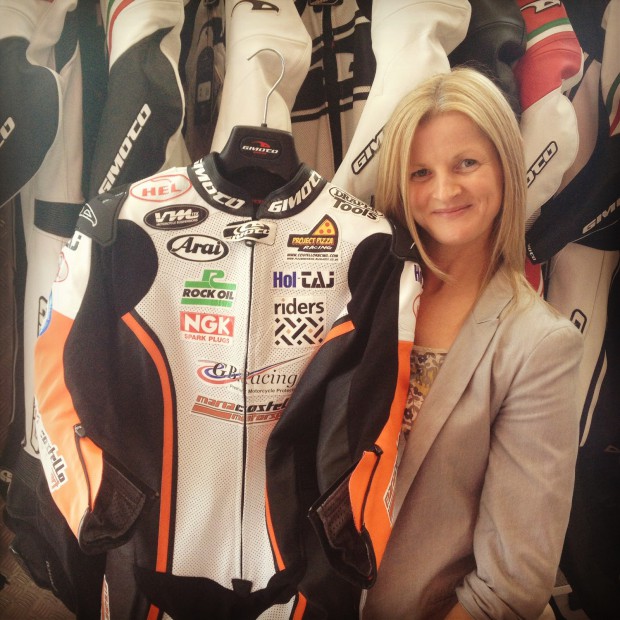
Maria Costello – TT legend and one of the fastest women on the planet.
But if you go barreling through the Hayshed at Phillip Island on a regular basis, you may want to re-evaluate just how much you want to spend on your leathers.
There’s a huge variation in the cost of leather suits, which can range from $300 to $3000. There’s also a correspondingly huge variation in the quality. But in short, you really and honestly do get what you pay for in terms of leather, armour, care in construction and research and development.
Higher quality leathers can take more abuse, and do the job of minimising your risk of injury in a high-speed spill at the track.

Macau – you need more than fluoro
That’s not just because the materials are better, but there’s more care taken in the construction of the garment.
So always consider where your leathers are made and is the emphasis on cheap output or high quality? If you do have an accident, and are in any doubt as to the integrity of your leathers, get in touch with us at www.ozmotorcycleleathers.com or catch up with us at the track. Repairs are often fairly simple and we can usually give you a few options depending on how you want to go.
As always, opinions and advice are free and knowledge is power.

